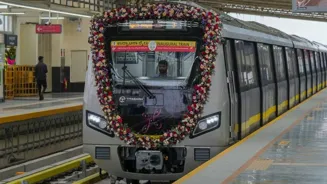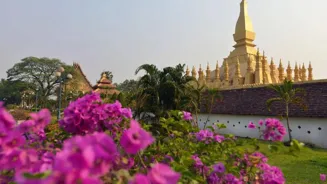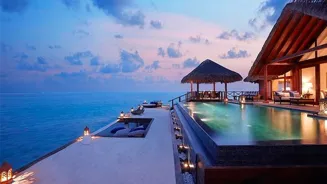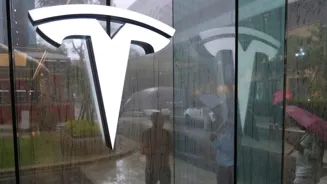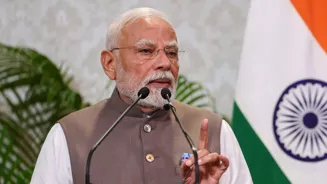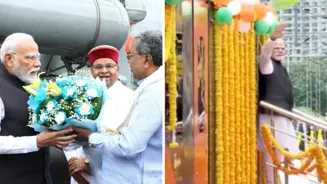On August 10, 2025, Prime Minister Narendra Modi inaugurated Yellow line of Bengaluru metro rail. Constructed at a revised cost of Rs 7,610 crore, the 19.15-km fully elevated corridor with 16 stations
connecting RV Road to Bommasandra industrial hub is expected to usher in a new era of fast, safe, secured and comfortable connectivity to city’s IT corridors and Bommasandra industrial hub, apart from reducing congestion on Hosur Road and Outer Ring Road.
Next only to Delhi
The 19.15-km (16 stations) Yellow line, along with 33.46-km (26 stations) Green Line and 43.49 km (37 stations) Purple line takes the operational network of Namma Metro to 96 kilometers and 85 metro stations (76 elevated, eight underground and one at-grade).
With the above, Bengaluru metro has now extended its lead over metro rail systems in other Indian metropolises – Hyderabad (69km), Mumbai (68.9km), Kolkata (59.38 km) and Chennai (54.1km) and now stands next only to Delhi which is way ahead with 395 km operational route kilometre and 289 stations.
1,055 km and counting
Also, with the opening of the Yellow line, the saga of the operational metro rail network crossed another milestone. From one 14.6-km line in Kolkata in 2000 and 214-km in five cities in 2014 (Delhi accounting for 188 of 214 km), Bharat has fast-tracked operationalisation of metro rail network to 1,055 km in 24 cities by 2025. This addition of 800 km operational network in past 11 years, adding 72.72km route kilometre per annum, has no parallel in the world outside China.
China is an altogether different paradigm about which I will talk later.
In the Fast Lane
Apart from constructing metro rail at a speed next only to China, Bharat has entered fast lane in one more special aspect- UTO (unattended train operations) technologically referred to as Grade of Automation 4 (GoA4), also known as fully automatic driverless operation. Although it will be initially operated with loco pilot to increase confidence of commuters, Yellow line becomes the first metro line in India outside Delhi to be equipped with fully automatic driverless (GoA4).
Also, Delhi Metro Magenta Line (38 km), Pink line (59 km) and Namma Metro Yellow Line (19.5 km) take the operational length of GoA4 fully automatic metro rail in India next only to China, Saudi Arabia and Singapore. And, with more such systems under fast-track construction in Delhi, Bengaluru and Chennai, sooner Bharat will have 409.1 km way ahead of other countries, but still far behind China.
Good and not so good
While inauguration of the Yellow line is the good news, it comes with its share of at least three, bad news:
1. Political Slugfest: Bengaluru Metro is a joint venture of the State Government and Government of India. As such it was rightly inaugurated by Prime Minister with Karnataka Chief Minister and Deputy Chief Minister in attendance. This being the case, the political slugfest between the state level leaders of parties ruling at the state and centre was not only bad politicking, but was also bad optics.
2. Metro rail with 25-minute headway is no metro rail: Operations on the Yellow line will begin at 5 am on August 11, with trains running every 25 minutes because so far Bengaluru Metro has received only three train sets. Agreed, the supply of metro coaches is the longest lead item of metro project, but the turnkey contract for 216 metro coaches Phase II of Bengaluru Metro, including 90 coaches for Yellow line, was awarded way back in February 2020 to Chinese company CRRC Nanjing Puzhen Co Ltd with the make in India provision Also agreed there was unexpected Covid-19 disruption and Galwan stand off , nonetheless time available was sufficient for all train sets to be deployed on Yellow Line to be in place before inauguration. But all BMRCL has is three trainsets while four are on the way.
The result is a headway between two trains of 25 minutes. For a high-density corridor like Yellow line, the desired peak hour headway is between two-three minutes or even lesser, despite the inauguration, for months if not years, due to high headway Yellow line corridor does not qualify to be called fully functional metro line.
3. Most congested city, slowest delivered project: For years Bengaluru has fought to be classified as among the most congested cities as per TomTom index. In 2024, it was ranked third most congested in the world after Barranquilla (Colombia) and Kolkata (India). A couple of days ago, it took two hours for me to navigate 2 km along the Yellow line corridor.
What I experienced is the rule and not the exception in Bengaluru.
Given the above reality, provisioning of urban mobility projects, particularly capex heavy metro projects needs within time and within cost completion to the clockwise precision which Delhi Metro has taught the world. Contrarily, Yellow line has been the slowest delivered project which from “planning to completion” has surpassed all metro lines constructed during the past 25 years. It suffices to say that this delay was both unwarranted and unavoidable. My explainer of it is hereunder.
Dream Disrupted
In a city like Bengaluru, which often gets the dubious distinction of globally most congested city, a project to ease urban mobility blues of citizens brooks no delay.
But Yellow line took a different trajectory.
As early as 2009, the BMRCL first planned to build a line in the southern end of the city to connect it to the industrial areas of Bommasandra and Electronic City. The DPR for Yellow line was prepared by the DMRC in 2011 with an estimated cost of Rs 4,255 crore and a completion target of 2016.
First delay – DPR to project sanction: Although the DPR was ready as early as 2011, it took three years for State and Central Governments to approve it. The final sanction of the Central Government was received in 2014.
Second delay – Sanction to foundation stone laying: In case of all four Phases of Delhi Metro, the time between project sanction and awarding contracts mostly took six months. Contracts for many critical long lead items in DMRC were often finalised within days of opening of the tender. In the case of Yellow line, it took three years after sanction of the project to just lay the foundation stone.
Third delay- Foundation stone to construction: By the time the foundation stone was laid for construction in 2017 (way past the original completion date envisaged in DPR), the project cost escalated to Rs 5,744 crore and a new completion date was extended to December 2021.
Fourth delay – Land acquisition: Metro projects require relatively land acquisitions – particularly around metro stations. Also, with DPR prepared in 2011 and project sanctioned by central government in 2014, all the land needed for the project should have been acquired latest by 2016 (Konkan railway acquired 760-km-long and 80-km-wide land in three states and six districts in one year), but delay in the land acquisition bogged down civil construction of Yellow line. That should not have been the case.
Fifth delay – Covid-19 & pandemic trouble: Covid-19 did shatter states and nation, but across the nation construction got delayed only for months and not years. So, it is futile to blame Covid-19 beyond a few months’ disruption.
Sixth delay – Chinese checker: While all other delays were manageable the Chinese Checker was not. While CRRC has done wonders for metro coach self-reliance for China the contract was bad news for India. And Galwan Clash made it worse. With China being on extended Covid-19 clampdown, the contract was a perfect one to be terminated citing “prolonged Force Majeure”. Even if a fresh contract was awarded to metro rail manufacturers in India, Yellow line would have arrived much earlier. Even now it has arrived only very partially.
Seventh delay – Leadership crisis: Indubitably, Yellow line passed through many crises. But crunch moments require posting tough leaders, empowering them fully and backing them with the full force of the government. Make no mistake, the tough job of Metro Rail MD is not for musical chairs or one of giving dual charge short term. It should not have happened with Namma Metro Yellow Line. It did happen. And the project bled.
Lessons Learnt
As per the original 2011 DPR prepared by DMRC the project should have been completed by 2016 at a completion cost of Rs. 233.10 crore per kilometer.
And the result is a metro rail project with the original estimated cost of Rs 233.10 crore per km in 2011. Even if the project was completed time bound with the revised 2017 cost, it would have been completed within a per Km cost of Rs 287.14 crore. If one believes the current cost estimate the project cost has already increased to Rs 402.1 crore per km. And here is my caveat. This completion cost is likely to increase to at least double of the original estimated cost to Rs 466 crore per km because there is often difference in the completion cost mainly because financial completion cost is usually known a year if not more after the physical completion of the project after all financial liabilities are accounted for.
The biggest lesson learnt from delay in construction and increase of completion cost of the project is, Bharat must retrace the path and learn from its own “Next Practices” which I deal with next.
Retracing Bharat’s Next Practices
In the past 27 years of close working with the metro rail revolution in the country and closely observing the unleashing of other made-in-India revolutions (Vande Bharat, low-cost space expedition and made-in-India defence equipment), I submit that to fast-track the low-cost metro rail revolution in the country, in place of searching for “global best practices” we must create or emulate “Bharat’s own Practices” (a phrase coined by India’s noted management Guru Late C.K. Prahalad in India@75).
Here they are:
1. Delhi Metro next practices: Delhi Metro constructed 65-km Phase I in 7 years 9 months (within original timeframe and original cost of 10,500 crores), 123 km phase II within a mind-boggling timeframe of 3.5 years (neck to neck with Beijing, China) and within estimated cost of Rs 18,500 crores to be ready by the time of Commonwealth Games in 2010. Admittedly, Phase I and Phase II were completed under legendary Metro Man E Sreedharan. But nearly 175-km phase III of Delhi Metro was completed within estimated cost of around Rs 40,000 crore in record time under his successor Mangu Singh.
Above apart, DMRC also constructed Metro Rail in Kochi, Jaipur, part of Mumbai and is presently constructing Patna Metro Rail. Successor of Mangu Singh, Vikas Kumar has extended the operational footprint to Mumbai Metro Line III and Chennai Metro Phase II, with the result DMRC will soom be operating and maintaining metro rail of a length next only to MTRC Hong Kong.
Key learning from DMRC “next practices” are choosing the right leadership, empowering them to take tough decisions fearlessly, giving them security of tenure, protecting from witch-hunting. I can write a paper on DMRC “next practices” and indeed have written one with Mangu Singh. My humble submission is if Delhi can do it, so can other cities. Technocrat or bureaucrat, there is no dearth of right leaders in the country.
2. Low-cost construction: Bharat needs no less than 10,000-km metro rail circled with buses and first and last mile connectivity to ensure sustainable mobility to 822-888 million urban dwellers by 2050 who will be contributing 75-80 per cent to the country’s GDP. The country already is on the path to have 5,000 km but must up the ante. But this cannot be done the way metro rail is being planned, financed and constructed in the country. There is no way but to drastically cut the unit cost of construction not only of civil works but more importantly systems and rolling stock. As regards rolling stock, Train 18 now Vande Bharat has already shown the way. Also, recent growth of domestic metro car manufacturers including of light-bodied aluminium coaches has already shown, manufacturing world-class metro coaches is no rocket science. Also, as metro car OEMs outsource two-thirds of parts it is time to create domestic ecosystems of part manufacturers. Further, the country must break the monopoly of signalling manufacturers through cheap world-class indigenous signalling and communication products. If the country can achieve the space miracle at a fraction of the cost of developed countries, it can do so even in the metro arena.
3. Changing the financing paradigm: While Bengaluru was celebrating the grand opening of Yellow Line, the state government was bickering that the central government had financed only 20 per cent of the project cost. It is true. But it is also true that in the current paradigm of 50:50 framework, 40 per cet of the prohect cost is provided 50:50 as equity equally contributed by central and state governments while the balance 60 per cent is usually soft loan from bilateral/ multilateral financial institutions backed by GoI guarantee.
But these so-called “soft-loans” which are now increasingly coming as “tied-loans” have started biting and my own calculation says these are increasing project cost by 20-25 per cent apart from the burden on currency fluctuation during the project life cycle. The better-informed government economists can calculate the true cost better.
I posit it is time to overturn the paradigm of financing metro rail or other urban mobility projects for a valid reason. Sooner by 2050 or even earlier, more than 850 million urban Bhartiyas will contribute to 75-80 percent of the country’s GDP. Attending to their mobility gridlock brooks no furhter delay. It is a good omen that the central government has increased annual metro construction budget 6X since 2014 to Rs 35,000 crore.
While the above is credible, it is not enough.
If Indian cities must retain their place as liveable and vibrant nodes of growth, prosperity and innovation, Bharat must change the paradigm to finance urban mobility infrastructure led by metro rail. It is an absolute must for the following three reasons-
- Where there is a will there is a way: The Central government has upped its annual capex budget for the highway sector to around Rs 2,72,000 crore. As both central and state governments construct roads and highways, I suspect that governments are spending almost the same amount of money on roads and highways as defence. It is time to altogether get rid of bilateral/ multilateral funding for metro rail and drive down the cost of construction. It is time now for both central and state governments to increase the budget for metro rail in the next five years to Rs 3,00,000 crore centre and state taken together if not more. It is an absolute must.
- Metro Rail cannot make money, do not look for absolute profit- The government of India with its revolutionary Metro Rail Policy 2017 has already accepted the truth that metro rail cannot make money. As such, the motive for provisioning of metro rail cannot be to make money but provide seamless, sustainable and affordable urban mobility. As such, GoI has changed the criteria to sanction metro rail projects from 8.4 per cent project FIRR to 14 EIRR to the city.
- Cleaning the cities: Apart from providing much needed sustainable and affordable mobility along with buses and first mile and last mile connectivity to remove “fast worsening urban mobility gridlock” as the experience of Chinese cities shows there is a throwback in terms of fast reduction of pollution in Indian cities.
Postscript
If India has to get its urban mobility paradigm right, all the above actions are needed urgently, but most important are one- Indian cities cannot any longer wait for sustainable urban mobility infrastructure, two, these must be constructed with the lowest possible life cycle cost and three, only the best and the fittest (the answer is neutral to technocrat versus bureaucrat debate) should be put in charge of provisioning, operating, maintaining and managing them.
Bharat can no longer afford political hesitation, bureaucratic delays, construction inefficiencies and leadership lapses and the project deadlines must be “sacrosanct”. And the task is so humungous Bharat cannot afford to begin “tomorrow”, it must start “yesterday”.
The author is a multidisciplinary thought leader with Action Bias, India-based international impact consultant, and keen watcher of changing national and international scenarios. He works as president, advisory services of consulting company BARSYL. Views expressed in the above piece are personal and solely those of the author. They do not necessarily reflect News18’s views.
